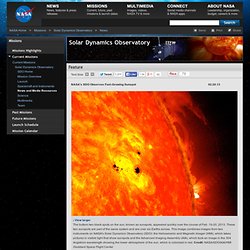

The sun's power in all its glory: Nasa captures 'best-ever' images of powerful solar X-flare. Amazing images of solar flares are captured by an amateur photographer in his garden. Dave Tyler, from a village near High Wycombe in Buckinghamshire used a five inch refracting telescope with specialist filters to take the images72-year-old captured violent solar flares and spots on the sun’s surface, which is 5,505°C and 93million miles (150million km) away from EarthThe images show solar flares as the sun goes through its ‘solar maximum’ – a period when it is most active that occurs approximately every 11 years By Sarah Griffiths Published: 12:23 GMT, 18 March 2014 | Updated: 14:43 GMT, 18 March 2014 Most people are content with spotting birds and butterflies in their garden.

But a British amateur photographer has set his sights a lot higher and has taken incredible images of the sun’s raging surface from his back yard. The 72-year-old managed to capture violent solar flares and spots on the sun’s surface, which is 5,505°C and approximately 93million miles (150million km) away from Earth. ‘Right now solar activity is at its maximum, but not its most spectacular.' The sun as you've never seen it before: Stunning images reveal the tumultuous inner and outer workings of our star. 'The sun as Art' images reveal scientific observations taken by the Solar and Heliospheric ObservatoryThey unveil a hectic world of powerful and constantly moving plasma cells appearing on the surface of our starOne image shows the sun blasting billions of tonnes of matter towards the Earth at millions of kilometres per hourAnother reveals dramatic changes on the sun by superimposing images of the star from three different UV cameras By Ellie Zolfagharifard Published: 15:33 GMT, 13 January 2014 | Updated: 15:47 GMT, 13 January 2014.

'Giant hole' in sun spotted by spacecraft. Sun's Magnetic Field to Reverse: What It Means. The sun's magnetic field, which spans the solar system, is just months away from flipping, observatory measurements show.

"This change will have ripple effects throughout the solar system," solar physicist Todd Hoeksema of Stanford University said in a statement. The 'gigantic hole' in the SUN that's firing solar material into space and was spotted by a spacecraft. The massive coronal hole - a dark, low density region of the sun’s outermost atmosphere - covered a quarter of the sunSpotted by the SOHO spacecraft, coronal holes contain little solar material, have lower temperatures and appear much darker than their surroundingsScientists are studying the holes to learn more about space weather, that could one day affect life on Earth By Sarah Griffiths Published: 15:26 GMT, 29 July 2013 | Updated: 23:08 GMT, 29 July 2013 A 'gigantic hole' in the sun's atmosphere, hovering over the solar north pole, has been photographed by a space telescope.

The dark spot, which covers almost a quarter of the sun, is a large 'coronal hole' - a dark, low density region of the sun’s outermost atmosphere, the corona. It was spotted by the European Space Agency/NASA Solar and Heliospheric Observatory (SOHO) spacecraft between 13 and 18 July, during which time it was spewing out material including solar wind into space. Scroll down for video... The sun gets the X-Factor: Most powerful 'X-class' solar flares of 2013 erupt from surface. Flares are first to be classified as 'X Class', the most intense, of 2013Spewed particles out at a staggering 745 miles per second - the equivalent of 4.32 million miles per hour By Mark Prigg Published: 13:17 GMT, 14 May 2013 | Updated: 15:19 GMT, 14 May 2013 This is the jaw-dropping moment the sun experiences one of its largest solar storms of the year as particles are blasted out at 1,200 miles per second.

Solar flares, which are the greatest explosive events we experience, take place on the Sun when energy stored in twisted magnetic fields is suddenly released. The bursts of radiation aren't a threat to humans, although when powerful enough they can disturb the atmosphere in the layer where GPS and communications signals travel. Scroll down for video. Three years of solar activity in three minutes - Nasa timelapse. STUNNING images reveal the sun's most powerful solar flare of the year. Flare caused temporary radio blackout on EarthClassed as 'mid-level' flare by NasaFlares expected to increase as sun moves towards its solar maximum later this year By Mark Prigg Published: 13:59 GMT, 12 April 2013 | Updated: 17:47 GMT, 12 April 2013 Nasa has released these stunning images of the Sun which show the biggest solar flare of the year.

The huge eruption on April 11th caused a temporary radio blackout on Earth, officials say. However, they warn the worst is yet to come - with this year expected to see the sun reach its 11 year solar maximum. Scroll down for video Nasa's Solar Dynamics Observatory captured this image of an M6.5 class flare at 3:16 EDT on April 11, 2013. Faint 'Red Arcs' Spotted Over Europe. Glowing red arcs invisible to the naked eye have now been detected high above most of Europe using advanced cameras pointed at the sky.

When streams of high-energy, charged particles come rushing from the sun to batter Earth, they cause what are called geomagnetic storms. These events are disruptions in the magnetosphere, the part of Earth's atmosphere dominated by the planet's magnetic field. The most dramatic effects of these storms are giant, bright auroras in Earth's polar regions, but the tempests result in other striking consequences as well, such as faintly glowing red arcs high up in the ionosphere. This is the electrically charged part of Earth's atmosphere, stretching from about 50 to 370 miles (85 to 600 kilometers) above the Earth. Smiling sun captured by amateur astronomer from a Wycombe back garden. Amateur solar-photographer Dave Tyler, 71, used a 5-inch refracting telescope equipped with a hydrogen-alpha solar filterShows a 'filament' - a snapped magnetic field, appearing to give the sun a facial expression By Mark Prigg Published: 11:24 GMT, 22 March 2013 | Updated: 12:24 GMT, 25 March 2013.

Solar Image Galleries. Nasa spacecraft watches two breathtaking eclipses of the Sun by the Earth and the Moon in less than seven hours. SDO Observes Fast-Growing Sunspots. NASA's SDO Observes Fast-Growing Sunspot › View larger The bottom two black spots on the sun, known as sunspots, appeared quickly over the course of Feb. 19-20, 2013.

These two sunspots are part of the same system and are over six Earths across. This image combines images from two instruments on NASA's Solar Dynamics Observatory (SDO): the Helioseismic and Magnetic Imager (HMI), which takes pictures in visible light that show sunspots and the Advanced Imaging Assembly (AIA), which took an image in the 304 Angstrom wavelength showing the lower atmosphere of the sun, which is colorized in red. Credit: NASA/SDO/AIA/HMI/Goddard Space Flight Center As magnetic fields on the sun rearrange and realign, dark spots known as sunspots can appear on its surface. The spot quickly evolved into what's called a delta region, in which the lighter areas around the sunspot, the penumbra, exhibit magnetic fields that point in the opposite direction of those fields in the center, dark area.
Related Links. 'Space storms' will cause 'widespread power cuts' and cripple phones, satellites and railway signals. Satellite navigation technology has never experienced a 'solar max'Changes in the ionosphere could cause problems with GPS By Anna Edwards and Damien Gayle Published: 09:16 GMT, 6 February 2013 | Updated: 13:09 GMT, 6 February 2013 Britain is facing crippling power cuts sparked by space storms that could scramble signals used in mobile phones, railways and satellites.

The Earth is beginning an 11-year peak in solar activity which a report claims could wipe out power at any moment. Sun storm threat to GPS: Space agency plans global network to study effects of 'solar max' on satellite communications. The Sun reaches the most active period of its 11-year cycle in summer 2013Increases in the number of sunspots will cause changes in the ionosphere that could interfere with radio transmissions from spaceGPS relies on transmissions timed to the split-second, and there are fears the interference could case serious problems with navigation By Damien Gayle Published: 13:04 GMT, 14 December 2012 | Updated: 17:14 GMT, 14 December 2012.
Fermi Detects Highest-Energy Light Ever - Space News. June 12, 2012 Lee Rannals for RedOrbit.com Lee Rannals for redOrbit.com. Nasa films TWO massive solar eruptions with power to down satellites. Published: 21:53 GMT, 18 November 2012 | Updated: 16:24 GMT, 19 November 2012 Two massive solar eruptions with the power to bring down satellites orbiting Earth have been captured in amazing detail by a NASA space camera. The stunning video shows an enormous pulse of super-hot plasma - called a solar prominence - bursting from the Sun's surface tens of thousands of miles into space. That mega burst in the early hours of Friday was followed just four hours later by a second. Scroll down for video. The Fires Below - an aurora seen by the International Space Station.